中西文化之鉴最终版
- 格式:ppt
- 大小:6.34 MB
- 文档页数:30

文素材:中西文化解读作文辅导1203 1202文素材:中西文化解读在现实生活中,我们能够深切地体会到中西方之间文化的差异。
在我们这个时代,任何狭隘的文化观点都是不可取的。
“闭关锁国”“夜郎自大”已成为我们过去的历史,但崇洋媚外、惟洋是举也不是我们的方向,知彼知已,在发扬本民族优秀文化传统的基础上实行“拿来主义”,方是明智之举。
文一:趣谈中西文化差异二三事王松绍饮食观念欧洲人都说世界上有三大美食,每一个版本里都有中国和法国的,只有关于第三家却说法不一,有说是意大利的,也有说是土耳其、突尼斯或摩洛哥等国的。
尽管相持不下,但大家都有个共识,饮食常能反映出不同民族的生活习惯和文化思维等方面的差异。
一次在中餐馆举行宴会,饭店菜上得很慢,不知不觉中过去了近两个小时,但菜似乎才上了一半。
临座的一位女士是第一次参加中餐宴会,忍不住问我,你们中国人请客都上这么多菜吗?我说,在中国还要多,通常是10道以上。
她很惊讶,连说中国的宴会实在太丰富了,难怪中国的美食很有名。
但过了一会儿,她又问我,有个现象很奇怪:中国人吃饭每次都上那么多菜,可为什么都长得那么瘦。
而法国入每次菜很少,但为什么都比中国人胖呢?我一时语塞,但又觉得她问得多少有点道理,因为那天同桌的几个中国人都显得比较瘦弱,而几个法国人个个人高马大。
想了想,和她讲了自己的一点想法:中国是个好客的民族,只有上了一桌子菜才觉得没怠慢客人。
另外中国人有时候更注重形式,所以在中国的烹调里,菜的样式千变万化,具体到每一道菜又非常讲究色香味的搭配。
而欧洲人似乎更实际一些,在菜的花色变化上下的工夫显然不如中国,但讲究的是其营养的搭配和保护。
这是中、法饮食观念的重要差异,多少也反映出了中法文化性格的不同。
对色彩的认识每个人都有自己喜欢的颜色,一个国家和民族也一样,对不同颜色的喜好从整体上可以反映出一个民族或者国家的审美情趣与好恶倾向。
有一次碰到欧盟委员会的一对教授夫妇,谈起上海APEC会议上各国领导人穿的中国民族服装,他们都说非常好看,但有一点不太明白,为什么亚洲领导人大多穿红色,而西方领导人则多选择了蓝色。
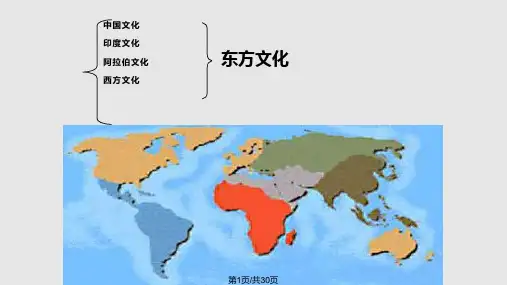
![中西方文化之鉴chapter7演讲稿[范文大全]](https://uimg.taocdn.com/9fd7a5b450e79b89680203d8ce2f0066f533649f.webp)
中西方文化之鉴chapter7演讲稿[范文大全]第一篇:中西方文化之鉴chapter 7演讲稿Good morning everyone , today ,I’ll tell you something about ‘Perceiving Culturally’.Generally speaking , ‘Perceiving Culturally’ means feeling cultures with your every sense to perceive the world, such as eyes , ears , nose , fingers , skin , even the muscles and nerve endings.And all the human beings’ hardware are similar , no matter who he is or where he lives.Then we use our similar eyes , nose , ears and muscles sense the world.Besides , when we speak of culture, we have to talk about the world ,actually I mean physical world.As we all know , the physical world exist apart from our ability to sense it.The moon , the mountain ,the sun exist even we have never been there or talked to anyone who has been there, they are just there.There is a physical reality that others know these things too.Just as I said , the world and the sense are quite similar ,but we still have so many different cultures.this is because our sense and the world beyond our bodies are physical realities that have noting to with culture.The world is too big ,thousands of places , thousands races ,thousands of areas.people live in different places ,then they became familiar with the place they live.if one of them come to an another place ,he will be uncomfortable about it.For example ,a man from a tropical country ,when he sees snow , he can’t point out the differences among the various types of snow ,except the help from native.Well ,before I read the article ,I can’t point out the difference among them too.When a European coming to an Asian country ,such as china ,for the first time ,he may think all of the people there look alike ,cause these people he sees with black hair and dark eyes everywhere , witchis quite different from his hometown.After a whole time ,this pool outland can adapt the environment.it is the same with the taste of food and the sounds of musicFor foreigners, various kinds of rice just taste alike.He can’t figure it out either unless we tell him the difference.See?Our sense and the world beyond our bodies are physical realities that have noting to with culture, yet we interpret the information we receive from our sense and this process of interpretation is molded by our own culture.Just like we feel uncomfortable when we be other places.And that is why when we see something are strange but quite normal among native.This is culture ,this the difference among cultures.As the author of the book said ,when she came to china ,everything need to be learned again ,how to ride a bicycle ,how to ride a bus ,how to climb a mountain ,even though she knew how to do all these things before she came to china.Sometimes , You know when you come to a new country ,everything need to be learned from the start, it is so troublesome and irritating.you have to spend a whole time to adapt the new culture and environment.This is easy to understand ,I will show you an interesting phenomenon.In about 30 countries and areas ,people walk and drive on the left.Such as UK, Australia ,Island, Japan and Singapore.As a matter of fact ,the countries that people walk on the left are not too many ,most countries’ people walk and drive on the right.(不同的国家拥有不同的生活习惯,当到达一个国家时,你得清楚这个国家的基本生活习惯,以防闹出笑话。
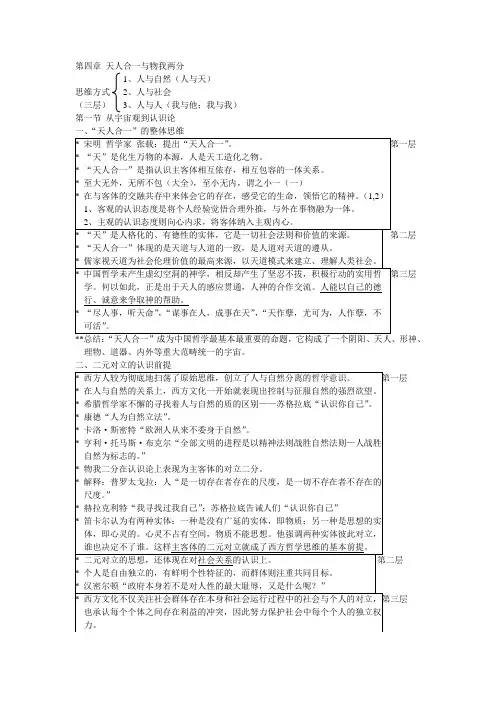
第四章天人合一与物我两分1、人与自然(人与天)思维方式2、人与社会(三层)3、人与人(我与他;我与我)第一节从宇宙观到认识论一、“天人合一”的整体思维**总结:“天人合一”成为中国哲学最基本最重要的命题,它构成了一个阴阳、天人、形神、理物、道器、内外等重大范畴统一的宇宙。
二、二元对立的认识前提* 萨特“地狱就是他人”。
* 二元的对立还表现为人自身的分裂。
(灵肉分裂)* 伊壁鸠鲁“是生活愉快的乃是清醒的理性,理性找出了一切我们的取舍的理由。
”(中世纪灵与肉的分裂达到绝对的程度)第二节直觉思维与逻辑推理一、主观联系的直觉思维* 直觉思维(联想思维)是非逻辑的思维。
* 直觉思维十分重视为认识者留下广大自由的主观空间,有极强的主观性。
* 直觉体验的个体主观性是不确定的,认识本身也就有极大的随意性,灵活性,这也许是直觉思维具有创造力量的原因,是中国哲学思维的绝妙之处。
* 重视个体性的西方文化,在思想和情感方面给了个人以诸多的限制,而重视群体的中国文化则给了个人以更多的自由。
* 直觉思维具有立体有机联系的特征。
(1,2,3)* 因为它是主观的,顿悟式的,是难以言说的;它是个体化的,是无法概括的。
* 联系性是直觉思维达到认识目的重要途径。
1、这种联系性首先建立在宇宙整体论的观念上的一切都在联系中。
“‘气’充一切虚,贯一切实。
”气无所不包,无所不在,它能贯穿一切有形无形之物。
2、思维的联系性还是互为因果,相互推动变化,彼此包容的联系;也是无所不在,超越时空、虚实的广泛联系。
3、中国思维的这种联系性还是辩证、转化的关系。
二、细剖精析的逻辑分析* 西方科学文化极发达,靠了两条重要的认知方法:一是可以理解的逻辑,一是可以控制的实验。
* 分析的方法包含两大步骤:1、细剖精析(* 在社会科学研究领域也不例外。
* 自古希腊的德谟克利特提出原子论起,原子一直被认为是构成物质的最小单元。
)2、建立逻辑的认识系统(* 切割细分得到单一、确定的认识,使认识具有可靠性、明晰性,是认识更深入。
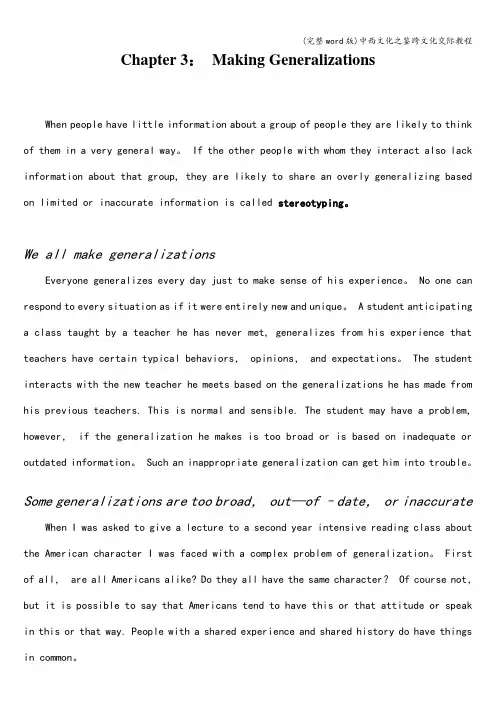
Chapter 3:Making GeneralizationsWhen people have little information about a group of people they are likely to think of them in a very general way。
If the other people with whom they interact also lack information about that group, they are likely to share an overly generalizing based on limited or inaccurate information is called stereotyping。
We all make generalizationsEveryone generalizes every day just to make sense of his experience。
No one can respond to every situation as if it were entirely new and unique。
A student anticipating a class taught by a teacher he has never met, generalizes from his experience that teachers have certain typical behaviors, opinions, and expectations。
The student interacts with the new teacher he meets based on the generalizations he has made from his previous teachers. This is normal and sensible. The student may have a problem, however, if the generalization he makes is too broad or is based on inadequate or outdated information。


中西方文化对比—-复习第一章导论比较文化或比较文明是20世纪人文科学研究的一大热点。
它的兴起不仅利益于人类在走向现代化进程中相互交流与合作的加强,也与后现代语境下价值多元化的趋势密不可分。
随着后殖民时代的到来,长期处在边缘的文明纷纷崛起,向西方中心主义的文化霸权发起挑战,形成了要求平等和对话的时代潮流。
在中国,文化比较研究的兴衰则与20世纪前后两期对外开放的潮流对古老传统的冲击,以及重新审视和发展中华民族文化的要求息息相关的.什么是中华文明的优秀传统?什么是当今世界的先进文化?只有把它放到人类文明发展演化的大背景下,放到全球文化多元共生的大视野中,才能得出清醒的判断。
回首人类文明的发生与交往史,东西文化的差异冲突是不容回避的话题。
长期以来,人们热衷于讨论中西文化孰优孰劣,究竟谁是先进或落后,但对其各自的渊源与特征却不甚了了,对文化差异与冲突的根本性质也缺乏认识.第一节全球语境下的文化选择1。
经济的全球化带动文化的全球化交通、信息和旅游业的发展使国际间的沟通与交流更加便捷和频繁,伴随而来的遍布世界各地的网吧、麦当劳快餐、摇滚乐和好莱坞电影,放佛让人感到自己正在成为地球村的公民。
这一切似乎向人们预示着一个文化全球化时代即所谓普世文明的到来。
联合国科教文组织2000年完成的《世界文化报告》指出:在进入21世纪时,全球化、长途通信和信息学正在改变人们界定和感受文化多样性的方法。
过去在文化相对主义背景下提出的“文化的马赛克”或“地球文化马赛克”的比喻已经过时,再也不能描述人们的文化偏爱了,“文化再也不是以前人们所认为的是个静止不变的、封闭的、固定的集装箱。
文化实际上变成了通过媒体和国际因特网在全球进行交流的跨越分界的创造.我们现在必须把问文化看作一个过程,而不是一个已经完成的产品。
"西方中心主义观念支配下,一些西方政治家和学者的观点:一个以西方式的自由民主制和自由主义价值观的普及为基础的全球一体化的时代的到来。
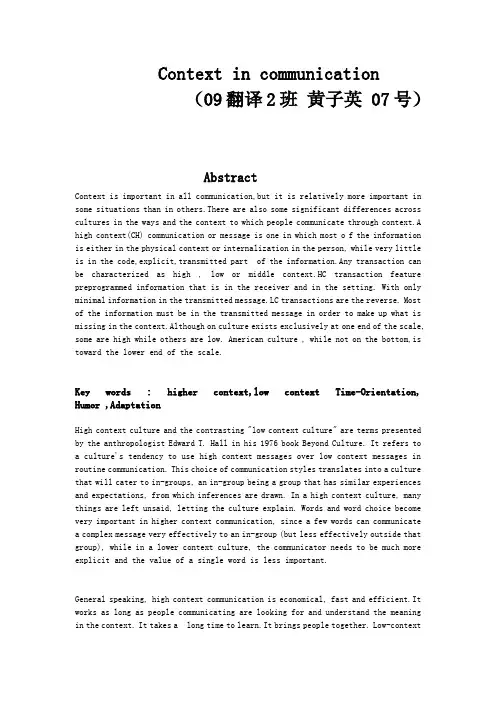
Context in communication(09翻译2班黄子英 07号)AbstractContext is important in all communication,but it is relatively more important in some situations than in others.There are also some significant differences across cultures in the ways and the context to which people communicate through context.A high context(CH) communication or message is one in which most o f the informationis either in the physical context or internalization in the person, while very little is in the code,explicit,transmitted part of the information.Any transaction can be characterized as high , low or middle context.HC transaction feature preprogrammed information that is in the receiver and in the setting. With only minimal information in the transmitted message.LC transactions are the reverse. Most of the information must be in the transmitted message in order to make up what is missing in the context.Although on culture exists exclusively at one end of the scale, some are high while others are low. American culture , while not on the bottom,is toward the lower end of the scale.Key words : higher context,low context Time-Orientation, Humor ,AdaptationHigh context culture and the contrasting "low context culture" are terms presented by the anthropologist Edward T. Hall in his 1976 book Beyond Culture. It refers to a culture's tendency to use high context messages over low context messages in routine communication. This choice of communication styles translates into a culture that will cater to in-groups, an in-group being a group that has similar experiences and expectations, from which inferences are drawn. In a high context culture, many things are left unsaid, letting the culture explain. Words and word choice become very important in higher context communication, since a few words can communicate a complex message very effectively to an in-group (but less effectively outside that group), while in a lower context culture, the communicator needs to be much more explicit and the value of a single word is less important.General speaking, high context communication is economical, fast and efficient.It works as long as people communicating are looking for and understand the meaning in the context. It takes a long time to learn.It brings people together. Low-contextcommunication is more impersonal,but it is an effective way of transmitting information among people we do not share the same experience.It pays little attention to messages sent to non-verbally, they think communication is the exchange of verbal messages.They think that the speakers and writers are responsible for the success of communication. They should make meaning clear and understandable with their words.Context as a relativistic metric of culture cultural context does not rank as "high" or "low" in an absolute sense because each message can be presented on a continuum from high to low. Likewise, a culture (French Canadian) may be of a higher context than one (English Canadian) but lower context than another (Spanish or French). Likewise, a stereotypical individual from Texas (a higher context culture) may communicate more with a few words or use of a prolonged silence, than a stereotypical New Yorker who is being very explicit, although both being part of a culture which is lower-context overall.Higher context cultures tend to correlate with cultures that also have a strong sense of tradition and history, and change little over time. For example, the Native Americans is a higher context culture with a strong sense of tradition and history. The focus on tradition creates opportunities for higher context messages between individuals of each new generation. This is in contrast to lower context cultures in which the shared experiences upon which communication is built can change drastically from one generation to the next, creating communication gaps between parents and children, as in the United States.High-context joke from a high context culture will not translate well to someone of a different culture, even another high-context culture. Humor is very contextual, as a joke may not be considered very funny if it seems like it is over-explained using only low-context messages.Adaptation an individual moving to a higher or lower context culture may need to adapt and/or be accommodated in ways different than moving within cultures of similar context.High to Low: An individual from a higher context culture may need to adapt and/or be accommodated when shifting to a low context culture. A lower context culture demands more independence, and expects many relationships, but fewer intimate ones.A high context individual is more likely to ask questions rather than attempt to work out a solution independently, and the questions are likely to be asked from the same few people. The high context person may be frustrated by people appearing to not want to develop a relationship or continue to help them on an ongoing basis. The term 'Hand-holding' might be used in an unintentional derogatory sense.Low to High: An individual from a low context culture needs to adapt and/or be accommodated when shifting to a higher context culture. Higher context culturesexpect small close-knit groups, and reliance on that group. Groups can actually be relied upon to support each other, and it may be difficult to get support outside of your group. Professional and personal lives often intertwine. A lower context individual may be more likely to try to work things out on their own and feel there is a lack of self-service support or information, rather than ask questions and take time to develop the relationships needed to accomplish the things that need to be done.After the knowledge of the high and low context , we will have a relation of the proper communication codes. It will not only contribute to the grasp of information and the communication between and it will definitely boost the international relationship development.。


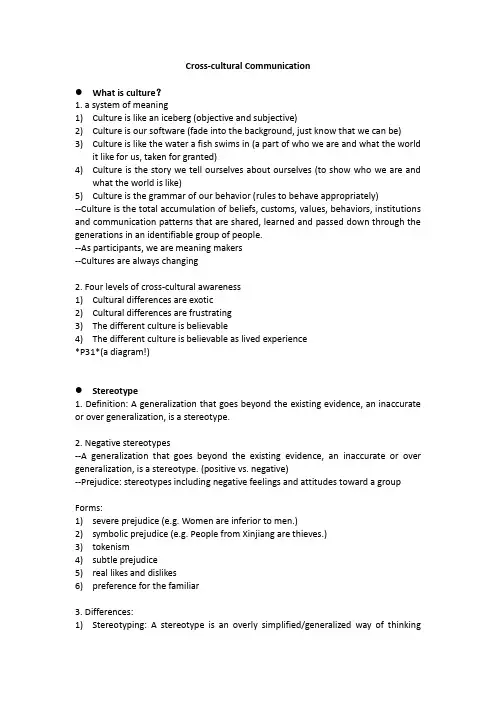
Cross-cultural Communication●What is culture?1. a system of meaning1)Culture is like an iceberg (objective and subjective)2)Culture is our software (fade into the background, just know that we can be)3)Culture is like the water a fish swims in (a part of who we are and what the worldit like for us, taken for granted)4)Culture is the story we tell ourselves about ourselves (to show who we are andwhat the world is like)5)Culture is the grammar of our behavior (rules to behave appropriately)--Culture is the total accumulation of beliefs, customs, values, behaviors, institutions and communication patterns that are shared, learned and passed down through the generations in an identifiable group of people.--As participants, we are meaning makers--Cultures are always changing2. Four levels of cross-cultural awareness1)Cultural differences are exotic2)Cultural differences are frustrating3)The different culture is believable4)The different culture is believable as lived experience*P31*(a diagram!)●Stereotype1. Definition: A generalization that goes beyond the existing evidence, an inaccurate or over generalization, is a stereotype.2. Negative stereotypes--A generalization that goes beyond the existing evidence, an inaccurate or over generalization, is a stereotype. (positive vs. negative)--Prejudice: stereotypes including negative feelings and attitudes toward a group Forms:1)severe prejudice (e.g. Women are inferior to men.)2)symbolic prejudice (e.g. People from Xinjiang are thieves.)3)tokenism4)subtle prejudice5)real likes and dislikes6)preference for the familiar3. Differences:1)Stereotyping: A stereotype is an overly simplified/generalized way of thinkingabout a person, group, etc. Anyone can stereotype and can be the target of stereotyping. Stereotyping is a complex form of categorization that mentally organizes your experiences and guides your behavior toward a particular group of people.2)Prejudice: Prejudice refers to the irrational dislike, suspicion, or hatred of aparticular group, race, religion, or sexual orientation. Learned beliefs and values that lead an individual or group of individuals to be biased for or against members of particular groups are prior to actual experience of those groups. 3)Relations between them:Both are a stumbling block to ICC. Prejudice usually refers to the negative aspect when a group inherits or generates hostile views about a distinguishable group based on generalization. These generalizations are invariably derived from inaccurate or incomplete information about the other group. The generalizations are called stereotyping.Context1. Definition: The meanings that people exchange in ways other than language are usually referred to as context.2. Low context:1)tends to prefer direct verbal interaction2)tends to understand meanings at one level only3)is generally less proficient reading nonverbal cues4)values individualism5)relies more on logic; employs linear logic6)saying no directly7)communicates in highly structured messages8)provides details, stresses literal meanings9)gives authority to written information(Characteristics: impersonal, effective to transmit information, not necessary to have relationships)E.G. contracts between companies3. High context:1)tends to prefer indirect verbal interaction2)tends to understand meanings embedded at many socio-cultural levels3)is generally more proficient reading nonverbal cues4)values group membership5)relies more on context and feeling6)employs spiral logic7)talks around point8)avoids saying no9)communicates in simple, ambiguous, noncontexted messages10)understands visual messages readily(Characters: economical, fast and efficient, take long time to learn, bring people together)E.G. communication between close friends and family members*P58 Figure3*4. How people use wordsLC: pay little attention to messages sent non-verballyHC: have no difficulty understanding the meaning of contextual messages5. Responsibility for successful communicationLC communicators: the speakers and writers of words are responsible for the success of communicationHC communicators: expect listeners to take more responsibility for interpreting the meaning of messagesVerbal Communication vs. Non-verbal Communication1. Contextual frameworkExpectant behavior 期待行为Expectant norms 行为标准Expectant identity 身份2. Verbal CommunicationVerbal intercultural communication happens when people from different culturalcontextual framework3 expectations:Expectant behaviorExpectant behavior normsExpectant identitystructure and content of discourses1) quality principleThe language we use to express should be understandable to the listener. Fun, honest, harmonious (what is the general principle.)2) quantity principleThe amount of information needs to be concerned.Keep quiet3) relevance principleThe relevant information to both sides is differentMarriage, salary and weight.Direct --- indirect communication4) expression principleTranslationVietnam culture3. Non-verbal Communication1) It refers to communication through a whole variety of different types of signal come into play, including the way we act, the gestures we employ, the posture we adopt, the facial expression we wear, the direction of our gaze, to the extent to which we touch and the distance from each other.2) Functions:a)Repetitionb)Contradictionc)Substitutiond)Accentuatione)Complementf)Regulate3) Elements:a)Body languageb)Eye contactc)Facial expressionsd)Vocal cues— pitch, rate, volume, quality, articulatione)Space and timeStory1. Factors to form guiding functions of stories1)characters2)conflict3)action4)result•世界的运行方式〔一般原那么和特定语境〕•我们的身份〔个人身份和社会身份〕•行为标准〔有效性和恰当性〕•判断尺度〔好与坏、平安与危险〕Individualism vs. Collectivism1. Individualism: pertains to societies in which the ties between individuals are loose. Everyone is expected to look after himself or herself and his or her immediate family.1) Manifestations:•personal privacy•personal freedom•personal equality•self-reliance•self-expression2) Advantages:•politics—democracy in America•economy—the thriving economy•culture—personal heroism•social life—personal desire comes first3) Disadvantages:•excessive disparities in wealthy•the existence of racial discrimination•other social problems2. Collectivism: pertains to societies in which people from birth onwards are integrated into strong cohesive in-groups, which throughout people’s lifetime continue to protect them in exchange for unquestioning loyalty.1) Manifestations:•group unity and harmony•group goals•hierarchy and interdependence•group-orientation•loyalty, conformity, humility2) Advantages:•community spirit—cooperate•economy—the thriving economy•culture—collective heroism•social life—one makes contributions to group3) Disadvantages:•not everyone has the team spirit•hierarch and personal inequality•leaders use public power for private•selfish in human nature•try to lazy and reduce payment as principle(*P232 Figure12!*)。
中西文化之辩内容摘要:伴随21世纪的到来,经济全球化的进程不断加快,中西文化的碰撞也越来越严重。
我们在吸收外来优秀文化的同时也应该弘扬中国五千年优秀文化。
在今之际,我们必须清楚地认识中西文化的差异,提取两种文化的精髓,不断的充实我们的民族文化。
通过对中西方的价值观、道德标准、教育方式的比较,使我们进一步了解我国传统文化的优点和不足,进一步了解西方文化的价值观和道德标准,以及教育方式。
关键字:价值观教育文化是社会的产物,是人类历史的结晶。
它凝聚着一个民族世代相传的社会意识,历史文化,风俗习惯等各方面人类社会所有的特征。
不同的文化背影和文化传统,使中西方在思维方式,价值观念,行为准则和生活方式等方面也存在有相当的文化差异。
在中国两千多年的封建社会历史的过程中,儒家思想一直占据着根深蒂固的弦统治地位,对中国社会产生了极其深刻而久远的影响。
中国人向来以自我贬仰的思想作为处世经典,这便是以儒家的“中庸之道”作为行为的基本准则。
“中”是儒家追求的理想境界,人生处世要以儒家仁、义、礼、智、信的思想道德观念作为每个人的行为指南,接人待物,举止言谈要考虑温、良、恭、俭、让,以谦虚为荣,以虚心为本,反对过分地显露自己表现自我。
不允许把个人价值凌驾于群体利益之上的,中国文化不主张炫耀个人荣誉,而是提倡谦虚。
反对王婆卖瓜式的自吹自擂,然而中国式的自我谦虚和自我否定却常常使西方人不满。
”YOU ARE ENGLISH IS VERY GOOD”:”NO NO MY ENGLISH IS VERY POOR”西方人看来不仅否定了自己,还否定了赞扬者的鉴赏力。
西方国家价值观的形成至少可追溯到文艺复兴运动。
文艺复兴的指导思想是人文主义,即以崇尚个人为中心,宣扬个人主义至上,竭力发展自己表现自我。
“谦虚”这一概念在西方文化中的价值是忽略不计的。
生活中人们崇拜的是“强者”“英雄”。
有本事,有才能的强者得到重用,缺乏自信的弱者只能落伍或被无情地淘汰。
中西文化对比与文化自信中国传统文化源远流长、博大精深,是中华民族的精神支柱、是我们的民族之魂、是发展社会主义先进文化的深厚基础、是建设中华民族共有精神家园的重要支撑。
弘扬中华传统文化是文化强国战略的需要,有利于提高我们的文化软实力。
但是,并不是所有人对中华传统文化都有着正确的认识,一提到中华传统文化就被冠之于“封建落后”,都是宫廷戏里面的那些东西,崇洋媚外,言必称西方。
十八报告指出我们要有民族自信、文化自信。
这就要求我们必须站在全球视角的基础上,站在人类文化历史发展的经络上,全面正确认识中华优秀传统文化,方能增强我们的文化自豪感。
中国传统文化源远流长,是世界上发源最早的文化在西方传统中,人们习惯称西方文化为“基督教文化”或“基督教文明”。
这是因为西方文化有着三大源头;以苏格拉底、柏拉图、亚里士多德古希腊三贤为代表的古希腊文明,发展为后来的科学传统;古希伯来文明和犹太教从对上帝的敬畏,引发出宗教原罪思想;古罗马法制文明,发展为近代法制观念。
而这三大文明都汇总于基督教,并以宗教信仰的形式在西方构筑起庞大的文化体系。
但是不管是古希腊文明的诞生,还是基督教的诞生,在时间上都远远落后于以老子和孔子以及先秦诸子百家为代表的中国传统文化。
公元前5世纪,对整个世界来说都是一个极其奇妙的世纪。
在这个世纪中,人类历史上几乎最聪明、最伟大的几个思想家:老子、孔子、释迦摩尼以及苏格拉底、柏拉图、亚里士多德等几乎一起诞生了。
因为历史上老子的生卒年月不详的缘故,历史学家们大都认为老子比孔子大约大20——40岁之间,释迦牟尼比孔子大14岁,比老子小10——20岁岁左右,孔子死后10年,古希腊的苏格拉底诞生,古希腊最聪明的哲学家亚里士多德比孟子大12岁,比庄子大15岁,阿基米德和韩非子只差了7岁。
也就是说,当古希腊的哲学家在希腊海边思考的时候,印度的哲学家正在在恒河岸边打坐,而中国的哲学家已经在黄河岸边散步。
当老子的道德经已经蔚为大观的时候,佛教思想刚开始萌芽,因此才有了老子西出函谷关而化胡的传说;而当儒家思想已经成为体系的时候,而以古希腊文明为基础的西方文明在孕育之中。